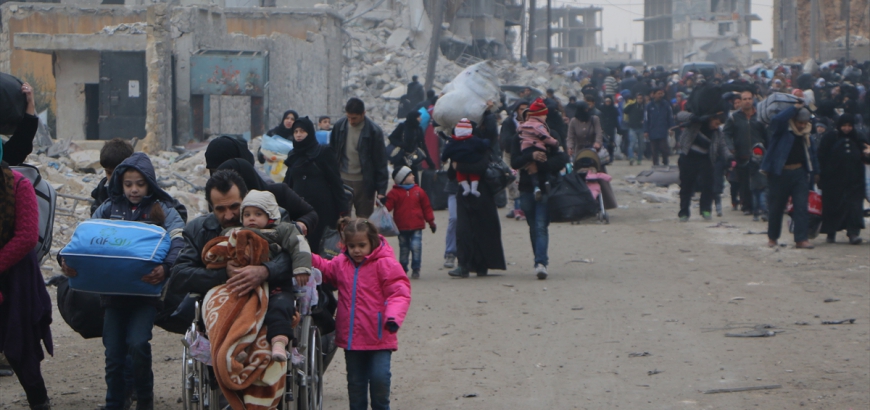The challenges throughout the journey from the eastern districts of Aleppo city to its western countryside did not prevent Yara (8), who arrived hours ago to the Rashideen district crossing in the northwestern countryside of Syria, from holding on to her bird inside a wooden cage she had clung to and carried with her as the rest of her family dragged their luggage and food which was distributed to them by aid workers.
But Yara is lucky because she, her family and her bird survived the hell of Aleppo which robbed another child, Rama (10), of her father, mother and siblings, and left her an orphan. According to the activists at the point where the green buses were emptied, Rama remained under the rubble of her home for three and a half hours after it was bombed two weeks ago, until civil defense rescuers pulled her out.
Rama, and about 100 other orphans, a portion of whom left the eastern districts the day before yesterday, will head to the orphanage in Idleb after losing their families and any incentive to cling to life in their hometown.
The UN’s child agency UNICEF said yesterday that about 50 children who were besieged in the orphanage in eastern Aleppo were rescued, and pointed out that some of them suffered from serious injuries and dehydration.
Krista Armstrong, spokesman for the International Committee of the Red Cross, said that the Syrian Arab Red Crescent and the international committee had evacuated orphans from eastern Aleppo and employees from the organization were caring for them. She added that orphans were treated as the priority and were the first to be transported in the buses when the process was resumed.
It is not only orphans who have surrendered to their unhappy fate, but hundreds of men and women who flocked yesterday to the Aleppo countryside after they were trapped by regime forces and their allied militias for long hours in the buses which transported them from the eastern districts of the city.
From their faces, they appeared frustrated and broken, and they did not hesitate to acknowledge this on camera and through their interview with the activist Maaz al-Shami, who relayed to Al-Sharq Al-Awsat multiple stories, in which “the common denominator for their heroes was that they were afflicted by a state of extreme despair, especially given that they had burned their homes and cars so that the regime forces and their allies could not benefit from them.” He said that “The tongues of the flames of their belongings continued to surround them during their trip to the Rashideen crossing and it will probably continue to surround them forever.”
According to Shami, about 20,000 people have left Aleppo’s eastern districts since last Thursday and have been distributed throughout areas in the northwestern countryside and in camps on the Syrian-Turkish border, specifically in Atmeh. He noted that some families had been secured in safe houses and others were living in tents in the camps, most prominently in the town of Kafr Karmin, established specifically to accommodate Aleppo residents.
The Rashideen district crossing in the western Aleppo countryside has turned into a point to receive buses of displaced people who are then transported by buses of the Free Syrian Army which distributes them in the previously noted areas.
Despite the desolate land increasing the depression of those arriving there, there are dozens of aid workers from multiple organizations and associations distributing food and water which alleviates, if only a little bit, their suffering.
Ahmad al-Dbis, the head of the unit of doctors and volunteers who are coordinating the evacuation, said that about 3,000 people had arrived on Monday morning to the areas under the control of rebel groups to the west of Syria’s second city, in convoys composed of 20 buses each. He said that he had seen since dawn families coming down from the buses and sitting on the ground, while aid workers distributed mineral water to them. Dbis added in statements to AFP: “The passengers, including women, children and elderly people, are suffering from the cold. They don’t have food or water.”
Maaz al-Shami said that, despite the fact that a number of Aleppo residents were saying in front of the cameras that they were returning to their homes, the biggest portion of them seemed convinced they had left their city forever. He said: “The fact that they burned their homes and cars before going may be the biggest evidence of that… Some of them told me frankly that they would try to establish a new life in Idleb.”
In a video published on his Facebook page, the prominent Syrian activist Hadi al-Abdullah documented the arrival of Bana al-Abed, the 7-year-old girl who was recording her days inside her home in the eastern districts of Aleppo over Twitter.
Mohamed Kaheel, head of the sharia medicine council in Aleppo, spoke about mass graves in which the dead were buried before departure because of the lack of space available. He said that “dozens of bodies remained in the streets which were not possible to bury.”
This article was translated and edited by The Syrian Observer. Responsibility for the information and views set out in this article lies entirely with the author.


